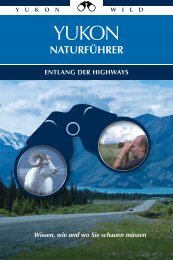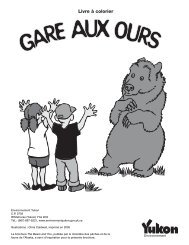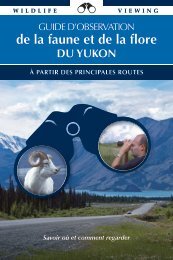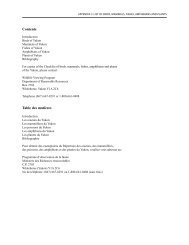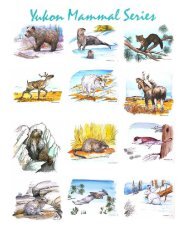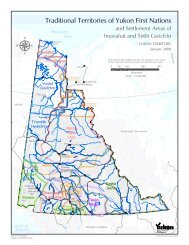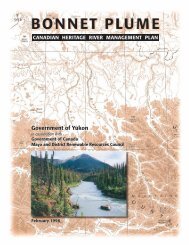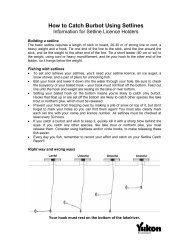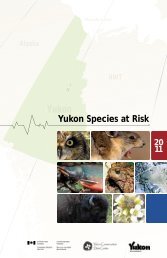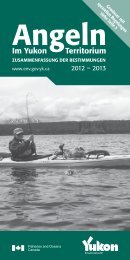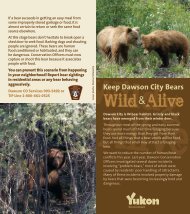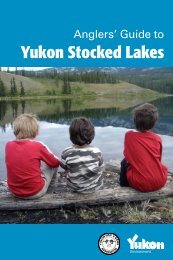Ch. 3 Land - Environment Yukon
Ch. 3 Land - Environment Yukon
Ch. 3 Land - Environment Yukon
Create successful ePaper yourself
Turn your PDF publications into a flip-book with our unique Google optimized e-Paper software.
Relationship of Agriculture to the<br />
<strong>Environment</strong><br />
In the <strong>Yukon</strong>, the major impact of<br />
agriculture is the conversion of land<br />
from natural to developed areas and<br />
the related loss of wildlife habitat,<br />
subsistence and trapping areas, and<br />
public recreation lands. Competing<br />
uses for land are particularly critical in<br />
the greater Whitehorse area. Most land<br />
with agricultural potential close to<br />
Whitehorse is either subject to land<br />
claim negotiations or has already been<br />
allocated. Interest in agricultural parcels<br />
is reaching further into the hinterland<br />
where there may be less conflict with<br />
recreational use, but more potential<br />
for negative effects on wildlife and<br />
subsistence activities.<br />
While competing interests between<br />
agriculture and other land and resource<br />
interests remain largely unresolved, the<br />
actual land area utilized for agriculture<br />
is small. An estimated 102 sq km, (1.5<br />
per cent of the <strong>Yukon</strong>’s 6,680 sq km of<br />
arable land) has been developed for<br />
farming. In terms of the total land area<br />
of the <strong>Yukon</strong> this accounts for only<br />
0.02 per cent. However, areas<br />
developed for farming are usually valley<br />
bottom lands, which are limited in the<br />
<strong>Yukon</strong> and are often key wildlife habitat<br />
or of high recreation value.<br />
As reported in the 1995 State of the<br />
<strong>Environment</strong> Report, the Takhini River<br />
Valley experienced a change from<br />
wildlands and habitat to farmland and<br />
rural residential over the past 20 years.<br />
While this farming area contributes<br />
to the supply of local food produce,<br />
the conversion of natural areas to<br />
farmland has been difficult for the<br />
First Nation families who traditionally<br />
used this area.<br />
The 1991 agricultural policy, required<br />
the consideration of other resource<br />
interests. Despite the more thorough<br />
review in the 1990s, the end result was<br />
limited accommodation for the<br />
traditional land users.<br />
Stella Jim explains how development<br />
affected her way of life.<br />
“Takhini valley, there is all fences<br />
now, and <strong>Ch</strong>ampagne. It was all<br />
wide open. Ever since that place<br />
has started farming, fences all over<br />
the place. Old people can’t hunt<br />
around where people used to<br />
hunt. Now it’s just a fence all over<br />
the place. You can’t go and step<br />
out there any place you want. All<br />
the way down, nothing but farm<br />
all over, from Stoney Creek to<br />
Whitehorse 5.”<br />
Several local area land use plans have<br />
considered other resource values<br />
(Klondike Valley, Lorne Mountain and<br />
Golden Horn). However, in 1999 there<br />
were no regional land use plans in<br />
place to assess agricultural land use in<br />
a broader perspective in relation to the<br />
overall land and resource values in a<br />
region.<br />
While land use allocation is seen as<br />
an important issue in terms of land use,<br />
there are other environmental concerns<br />
that have been raised. Disease transmission<br />
and genetic contamination are<br />
concerns with game farming. Currently<br />
there are six game farming operations<br />
in the greater Whitehorse area.<br />
These include wood bison, elk and a<br />
commercial game farm with a variety of<br />
animals. About 585 hectares is used<br />
by game farm operators at present.<br />
There is no evidence of genetic contamination<br />
or disease transmission to<br />
date 4.<br />
Fish habitat can potentially be affected<br />
by agricultural activities but no records<br />
of significant fish habitat degradation<br />
from agriculture have been noted.<br />
Soil erosion and pollution from<br />
agricultural activities can cause soil<br />
degradation if clearing and cultivation is<br />
not carried out in a sound manner. The<br />
<strong>Yukon</strong> Agriculture Branch monitors<br />
agricultural practices to prevent soil<br />
degradation.<br />
PROGRESS & CHALLENGES<br />
Progress since 1995<br />
■ Agricultural sales have increased<br />
from $2.3 million in 1991 to<br />
$3.5 million in 1996, indicating<br />
that the use of land for<br />
agriculture has fairly significant<br />
economic benefits to the <strong>Yukon</strong> 2.<br />
■ Ibex Valley, Mount Lorne and<br />
Golden Horn local land use<br />
plans that identified agricultural<br />
lands in an integrated approach<br />
have been prepared.<br />
■ The agricultural policy has been<br />
reviewed.<br />
■ The <strong>Yukon</strong> <strong>Land</strong> Use Planning<br />
Program, that is expected to<br />
address the disposition of<br />
agricultural land use in an<br />
integrated approach, has been<br />
established.<br />
<strong>Ch</strong>allenges<br />
■ Continuation of the spot land<br />
allocation process for most<br />
agricultural dispositions.<br />
■ Lack of an adequate supply of<br />
rural residential lands, resulting<br />
in pressure on the agricultural<br />
land program.<br />
■ Under-utilization of land<br />
disposed of for agriculture.<br />
■ Increasing pressure for the<br />
subdivision of agriculture land.<br />
3.7 Transportation<br />
The story of the <strong>Yukon</strong> is linked to the<br />
territory’s transportation network.<br />
Before the Gold Rush, people traveled<br />
by foot, dog team, boat, on trails and<br />
by river, leaving little evidence of their<br />
passage. During the Gold Rush, local<br />
roads were developed in the Klondike<br />
region and travel through the <strong>Yukon</strong><br />
was enhanced by the railway from<br />
Skagway to Whitehorse, better overland<br />
trails between communities and a<br />
river boat system. Signs of past users<br />
6 4 ❧ Y U K O N S T A T E O F T H E E N V I R O N M E N T R E P O R T 1999





